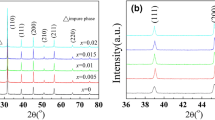Abstract
Compositions in (Na1/2Bi1/2)TiO3 based ternary system, (0.97 − x) (Na1/2Bi1/2)TiO3-0.03NaNbO3-xBaTiO3 (x = 0, 0.01, 0.02, 0.04, 0.05, 0.06, 0.08) are synthesized using conventional solid state reaction method. Influence of BaTiO3 on crystal structure, dielectric and piezoelectric properties are investigated. All compositions can form single perovskite phase. Powder x-ray diffraction patterns can be indexed assuming a pseudo-cubic structure. Lattice constant increases with the increase of BaTiO3 concentration. Rhombohedral distortion is observed in poled samples with BaTiO3 concentration up to 6 mol%. Temperature dependence of dielectric constant and dissipation factor measurement reveals that all compositions experience two phase transitions: from ferroelectric to antiferroelectric and from antiferroelectric to paraelectric. Both transition temperatures, T c and T f, are lowered due to introduction of BaTiO3. Ferroelectric to antiferroelectric phase transition has relaxor characteristics. Piezoelectric properties have relatively higher value around 1 mol% to 4 mol% BaTiO3. In ceramics with x = 0.02, thickness electromechanical coupling factor (k t) of 0.51 and piezoelectric charge constant (d 33) of 110 × 10−12 C/N are obtained. Addition of small amount of BaTiO3 (x = 0.01, 0.02) improves piezoelectric properties compared to NBT-NN binary system, while T f remains above 140°C, higher than that of NBT-BT binary system composition with similar piezoelectric properties. This is in favor of the possible application of them as lead-free piezoelectric ceramics.
Similar content being viewed by others
References
T. Takenaka and K. Sakata, Ferroelectrics 95 (1989) 153.
T. Takenaka, K. Sakata and K. Toda, ibid. 106 (1990) 375.
T. Takenaka, K. Maruyama and K. Sakata, Jap. J. App. Phy. 30B (1991) 2236.
T. Takenaka, T. Okuda and K. Takegahara, Ferroelectrics 196 (1997) 175.
A. Herabut and A. Safari, J. Amer. Ceram. Soc. 80 (1997) 2954.
S. Kuharuangrong and W. Schulz, ibid. 79 (1990) 1273.
S. Said and J. Mercurio, J. Euro. Ceram. Soc. 21 (2001) 1333.
S. Kuharuangrong, J. Mater. Sci. 36 (2001) 1727.
Author information
Authors and Affiliations
Rights and permissions
About this article
Cite this article
Wu, Y., Zhang, H., Zhang, Y. et al. Lead-free piezoelectric ceramics with composition of (0.97−x)Na1/2Bi1/2TiO3-0.03NaNbO3-xBaTiO3 . Journal of Materials Science 38, 987–994 (2003). https://doi.org/10.1023/A:1022333427521
Issue Date:
DOI: https://doi.org/10.1023/A:1022333427521




